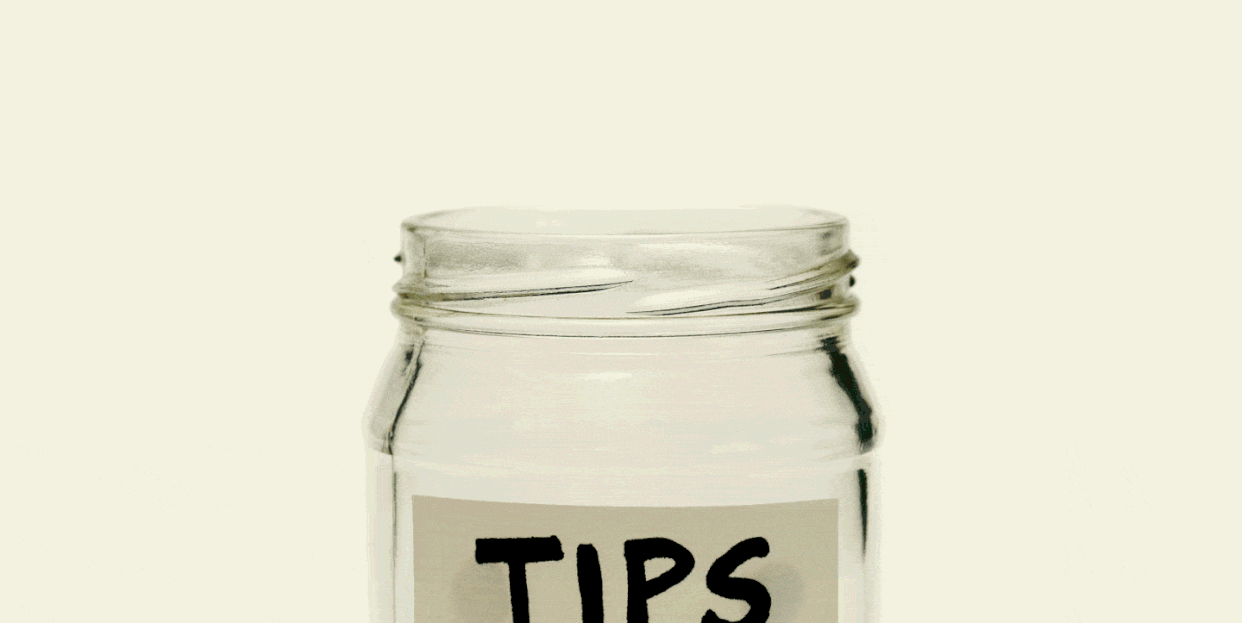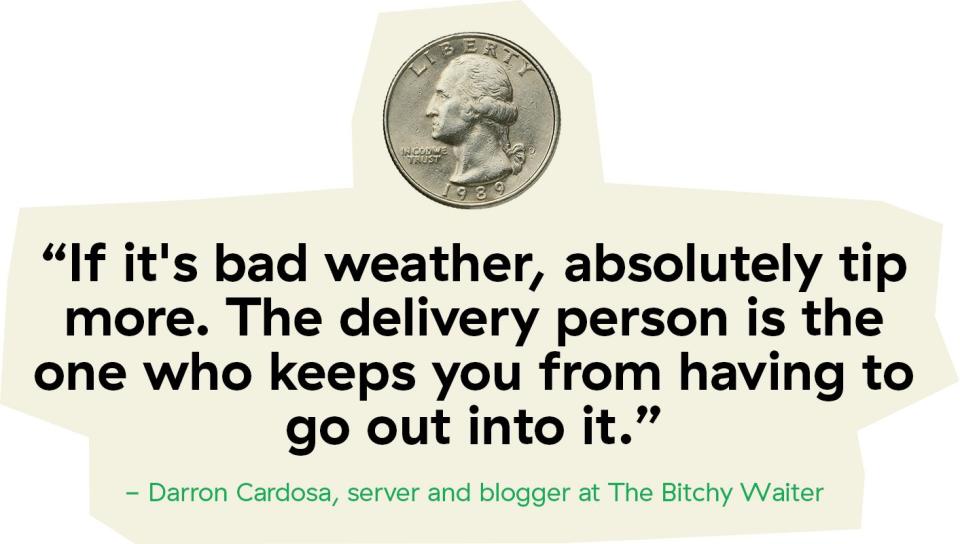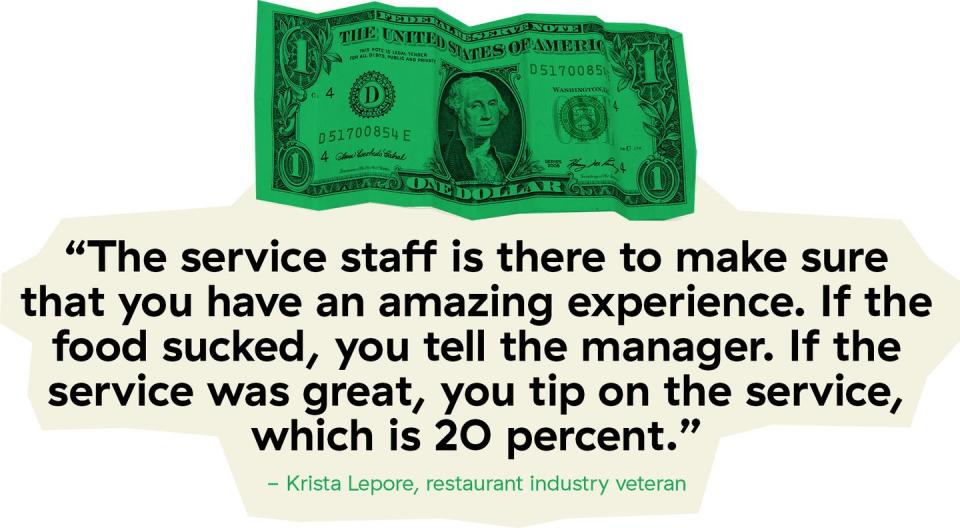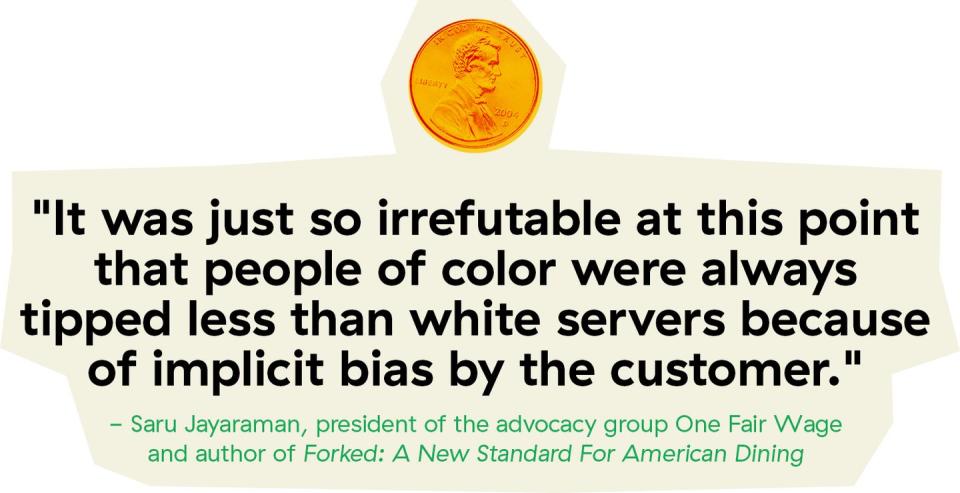How Much Should You Tip?

We’ve all been there. You place your order at a coffee shop or pizza joint. The cashier turns the iPad screen around, and there are three tip amounts for you to choose from: 15, 20, and 25 percent, plus an option at the bottom for no tip. You feel the pressure from the cashier. Are you taking too long? There are people behind you in line who can clearly see how much you’ll tip. You’ll feel like a jerk if you don’t tip anything.
It wasn’t that long ago when you didn’t tip at establishments like this. There used to be a jar in which you could drop some change or a few bucks, sure, but tipping didn’t feel this widespread. Tipping via a flip-around iPad screen at spots that aren’t sit-down restaurants started before the pandemic. With the dawn of Apple Pay, retail environments incorporated tipping into their checkout process as a way to copy the restaurant-industry model.
“They try then, in many instances, to drive the workers’ wages down from the minimum wage to the sub-minimum wage,” said Saru Jayaraman, president of the advocacy group One Fair Wage and author of Forked: A New Standard For American Dining. That way, the business had less responsibility to pay their workers—they were tipped just like servers. “We saw coffee shops in [Washington] D.C. that implemented this implanted tipping for the first time and attempted to then drive the workers' wage from $15 [an hour] down to $3.”
This has created an environment where tipping is everywhere, and you don’t always know how much to tip. So we reached out to folks in the service industry to get their views on tipping for different circumstances. Use this as a guide the next time you're not sure how much to leave.
I’m ordering takeout from a restaurant. Should I leave a tip?
Yes, at least 10 percent.
“I always tip 20 percent for takeout, but it deserves at least 10 percent,” said Darron Cardosa, server and blogger at The Bitchy Waiter.
I’m ordering delivery from a restaurant. What should I tip the delivery person?
No less than $5.
Alejandro Rodriguez, server at the restaurant Melroseplace in Los Angeles, thinks 15 percent is a good number.
Katrina Sobredilla, head bartender at 8282 in New York City, thinks no less than $5. “I can’t even imagine delivering on a bike and how difficult that would be,” she said.

What if it’s snowing or raining outside?
If the weather is bad, tip more.
“If it's bad weather, absolutely tip more,” Cardosa said. "The delivery person is the one who keeps you from having to go out into it.”
“For me, I always tip 20 percent across the board,” said Krista Lepore, who has worked in the restaurant industry for more than 20 years and hosted the Travel Channel’s American Roadhouse. “If the weather is bad, I tip more, especially if this is a place that you always order from.”
I buy a drink at the bar with my credit card. How much do I tip?
At least 20 percent.
“Always over 20 percent,” Sobredilla said. “If I need another one, the bartender usually will come to me first or remember me for the next time I come in.”
Rodriguez and Lepore agree.
What if the food at a restaurant was bad, but the service was good?
Still tip at least 20 percent.
“The tip is based on service, not on whether or not the food was to one's liking,” Cardosa said. “I wish customers could understand that leaving a bad tip because the food was bad only hurts the server, who had nothing to do with how the food was prepared.”
Lepore echoed this sentiment. “The service staff is there to make sure that you have an amazing experience,” she said. “If the food sucked, you tell the manager. If the service was great, you tip on the service, which is 20 percent.”

What if the service was bad, but the food was good?
20 percent. We all have bad days.
Jayaraman said it’s best to always stick with 20 percent or more. That way, your implicit biases aren’t affecting your tipping. “People at this moment in most states still rely on that as their wage. If you think about any other customer-facing profession—a doctor, a lawyer, a teacher—their income does not depend on whether they please you,” she said. “If we understand that tips are still just payment for people to do the job, then it shouldn't be based on whether they please us or not. It should just be a flat 20 percent.”
“Even if it all sucked, I’d still tip 20 percent. We all have bad days or off days,” Sobredilla said.
“Even more helpful would be to let management know that the service did not live up to the level of food,” Cardosa said. “This suggestion should be done discreetly and not left in an online review calling the server out by name.”
Say I’m at a fast casual place and they have an iPad at the register with options for a tip percentage. Do I tip?
Yes, even if only a little.
“If there’s an option to tip, I end up tipping, even if it’s just $1,” Sobredilla said.
Lepore says this can be a tricky situation. “If you feel the service was great, friendly, engaging, and they really wanted to make you happy, then I would tip.”
“It’s not rude to not tip, but obviously, the team working will be highly appreciative,” Rodriguez said. “Coffee shops are generally the easiest way to become recognized as a regular and hopefully have a quicker wait time for your beverage.”
Do I tip the barista at a coffee shop?
Not necessarily 20 percent, but yes.
“I tip the barista because when it’s busy and they see me, they always make my drink when I walk through the door,” Sobredilla said. “Even if it’s not a regular spot. I need my caffeine.”
“I feel like a barista is doing a service for the customer, so a small tip is warranted,” Cardosa said. “It doesn't necessarily need to be 20 percent of the cost of the double mochaccino caramel frappe.”
What if the restaurant says gratuity is included?
You don't need to tip on top of it.
“If the restaurant says the gratuity is included, it may be against policy for the server to accept an additional tip,” Cardosa said. “Read the fine print. Is it a service charge that goes to the restaurant or a gratuity that goes to the staff?”
“I leave it as is, because sometimes they don’t have that option of [accepting additional tips],” Sobredilla said.
But Lepore said this model, popularized by restaurateur Danny Meyer, can be inauthentic. “It was a way to rob Peter to pay Paul, and everyone who works in a ‘hospitality included’ restaurant makes 20 percent less than tipped employees,” she said. The Danny Meyer model, as she called it, pays its workers minimum wage plus the 11 percent food and beverage sales from the day split among all staff. The model used by Amanda Cohen, chef and owner of the NYC restaurant Dirt Candy, pays everyone $25 to $27 per hour. “Either way, it's not a living wage in NYC unless you live in a two bedroom with four roommates,” she continued. “Bring cash and TIP.”
Jayaraman recommends seeking out the places that pay their workers a living wage and offer benefits. “Support the thousands of restaurants that are now doing the right thing by paying a full wage and having tips or gratuities be on top of that,” she said. Here’s a resource to find restaurants doing that in your state.
Why have some restaurants moved away from the tipping model?
There are a few reasons. The biggest ones, Jayaraman said, have to do with biases against servers.
“What was problematic pre-pandemic with having tips as wage replacement was not only that it was a very precarious and economically unstable way to live that resulted in tipped workers experiencing three times the poverty level of other workers,” she said. “It was also the reason why there was such high harassment and such great levels of racial inequity in the industry. Over two thirds of tipped workers in America are women. And it was just so irrefutable at this point that people of color were always tipped less than white servers because of implicit bias by the customer. It's never been about the quality of service. It's always been about the look, the race, the gender of the server. You know, if she's a woman, whether she allows herself to be touched, the size of her breasts, the color of her eyes, the color of her hair.”

You’re paying the bill for a large party. Do you tip more than 20 percent?
Extra work means extra tip.
“I tip a little extra in the beginning to say thank you for having to take us,” Sobredilla said.
“If the server went above and beyond, it's always nice to throw in a little bit extra,” Cardosa said. “No server is going to be disappointed with more than 20 percent, but every server is going to be happy with 20 percent.”
Rodriguez said, “The tip should be roughly 22 to 30 percent based on the group's needs.”
Lepore posed an important question: “Were you high maintenance? Seriously?” she said. “Was it a birthday or celebration with gifts and decorations and you left the server to clean all of that up after you left? Tip more!”
You Might Also Like

